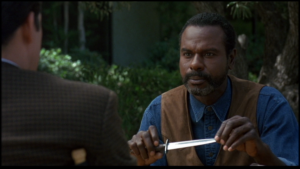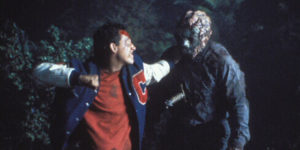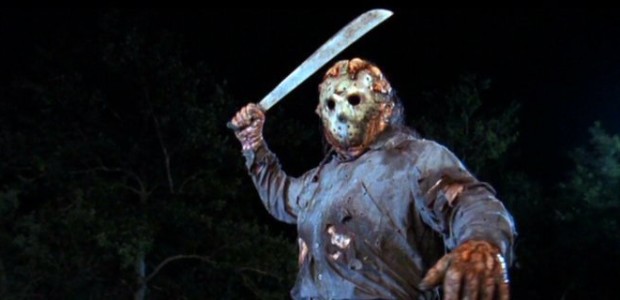Jason Voorhees went to hell for our cinematic sins. We shouldn’t let it be in vain.
On the inaugural entry of MISBEGOTTEN/FORGOTTEN, Nathan Smith takes a look at the maligned JASON GOES TO HELL and tell you why it’s the most underrated of the franchise. THE FINAL FRIDAY is the most underrated film in the FRIDAY THE 13th franchise; that’s a bold mission statement. This film is pretty damn fun. It’s a hell of a gamble to make this kind of film, and frankly, it pays off immensely.
I’ve had a long history with the FRIDAY THE 13th films. I’ve seen them so many times that I could conceivably recite the dialogue backwards and forwards with little trouble at all. They’re absolutely my favorite films of all time. I treasure my copy of ‘From Crystal Lake to Manhattan.’ I own the massive and essential book written by Peter Bracke, which for even a fringe Friday fan is a definite buy. In my heart, I hold the fondest of spots for the sleazy franchise that deserves more love than it’s gotten over its three decade career. JASON GOES TO HELL was the first Friday I ever saw. That’s stuck with me.
By the time JASON GOES TO HELL was released in 1993, the series had seen its fair share of troubles. Paramount Pictures had given up the franchise rights to New Line Cinema; Jason simply wasn’t killing it at the box office anymore. JASON TAKES MANHATTAN was (undeservedly) received as the worst entry in the series, both financially and critically. As Jason Voorhees entered his second decade, the question arose, what would become of Crystal Lake’s mad maniac? What would they do with the FRIDAY THE 13th series? Would it die a lonely death at the bottom of a cold, crisp lake?
As early as FRIDAY THE 13th, PART VII: JASON LIVES, the idea of Freddy Krueger taking on the perennial campground slasher was swimming in the minds of horror fans everywhere. Legal objections due to rights, notwithstanding, the promise of the celluloid showdown that these two titans of horror could stir up was more than enough to get fans into seats. But, even with the exciting thoughts that premise drew, the concern on Sean Cunningham’s mind was “does anybody still care about a new Jason movie?” And if he was to prove that there was a voice for the fans out there, he needed a face to bring this to the forefront. Someone who could prove that there was still oily blood in the dark heart of Jason Voorhees.
Enter Adam Marcus, a fresh-faced twenty-three year old film student who was ushered in as the director who would resurrect Jason Voorhees to the silver screen. With the collaborations of Dean Lorey and Jay Huguely, they would craft a story that would bring something new and fresh to the screen that would change the way we perceive a “Friday the 13th” movie forever. And boy, did it ever.
When Jason Goes to Hell opened on August 13th, 1993, it did so pretty successfully with an opening weekend gross of $9,777,000 and a total domestic gross of $15,935,068 . Reviews were not favorable because frankly, at that time in cinema, if FRIDAY THE 13th was on the marquee, most critics just assumed it was more of the same. It was still something old, even with fresh faces and a fresh script.
But JASON GOES TO HELL tried something new, all the same. Here’s where it all changes. Here’s where the defense presents their case. There are many ways to approach what the film brings to the table. We’re going to examine them like our ill-fated coroner examined the smoky remains of our undead killer.
JASON GOES TO HELL offers us exactly what we want from a FRIDAY film. There’s your smattering of bare flesh and bloody victims meeting their ends at the end of whatever implement that Jason Voorhees fancies. Make no mistake, it’s a big body-count film, featuring some of the best deaths in the series, packed with nice splattery effects courtesy of the terrific KNB Effects. The tent set-piece is a definite highlight of the film in terms of outrageous gore effects, and it was done as a reshoot to make the film more like a traditional stalk and slash. The other set-piece, late in the film at Joey B’s Diner, is a cool-slow-motion shootout that gives the series some gravitas as well. Jason Voorhees looks pretty stellar here as well, with the effects guys aiming to stick to Carl Fullerton’s look from Part 2. It’s one of the iconic looks for Jason. Kane Hodder, limited though his time as the titular killer is, has owned the part by this point, and plays the sentient killer slab of meat to perfection.
JASON GOES TO HELL also tries something new within the parameters of the established franchise. You get a sense of community in Crystal Lake for this entry. Sure, you’re presented with your typical cannon fodder replete with unlikable people, but like earlier entries, there’s a real need to have these characters matter. It’s filled with adults and their families. Businesses thrive on the death of this former killer. Law enforcement are active and present in people’s lives. Newscasters tell the world of Jason Voorhees. He’s no longer just an urban legend told around a campfire. He’s an American Case File.
And there’s a bounty hunter that’s a few machetes short of a sporting goods store by the name of Creighton Duke.

From minute one, it sets itself apart from the pack. The opening minutes of the film are designed to wink at the audience, in a way that “Scream” would do just three years later. Adam Marcus and his writers are saying, “Hey, here we are! Let’s have some fun! I’ll zig when you think I’m going to zag.” That’s where the film shines, in this meta-commentary on the franchise overall, because it plays on the expectations and twists them in ways you wouldn’t expect. The opening makes a meal of fake-out jump scares. Personally, if I go to a film expecting one thing, and it becomes a whole new thing, I’m going to be a happy camper (tongue in cheek?). But alas, I’m not like other fans of horror. And any film that blows up the main villain ten minutes in should be getting your attention. Why the hell didn’t audience members sit up and feel the same way?
This is where things get a little prickly. But stick with me, dear reader.
New Line Cinema had done a body-swapping film with THE HIDDEN in the 80’s, a film that’s pretty fun in its own way. And if it worked for that film, why not work for JASON GOES TO HELL? Because at this point, the hacking and slashing had been done over and over again. The story’s been told. So why not try something new? Isn’t that the chief critical complaint? It’s the same thing? So, why is it then when this film, the ninth entry in its respective series, tries something new, it gets its head unfairly lopped off?
The mythology is confusing, because it asks a lot for the viewer to betray what we know about the series so far. Writing a mythology for a character that’s already mythic in nature can be complicated but it’s pulled off pretty well. We’ve seen Jason resurrected so many times, by so many different means, that it couldn’t be a stretch to buy that maybe Jason isn’t a person, but rather a spirit, an ‘other’, that just happens to be in the form of a slimy grey slug. My personal takeaway from the whole piece, and I could be wrong, was that Jason did die all those years ago, when he “drowned.” The slug thing infected his dead body, and he was then brought back to life, killing all those he dared entered his forest. Even doing this, you’re ignoring the continuity that’s been established thus far (though continuity has always been the weakest point of the series).
And with all that mythology, you’re going to need exposition. It’s the curse of the script. Having Creighton Duke, a character that’s an exciting and interesting addition to the Crystal Lake canon, dole out all the details of the story could have weighed heavily on a film that was moving fast up until that point. And, okay, it does. Just a little bit. But, it’s at least done in a way that doesn’t betray the character of Creighton Duke established up until that point. The finger-breaking exposition at least makes the audience complicit in the violence. We need to know more, so we want poor John LeMay to suffer for want of our knowledge. I personally like Steven Williams’ portrayal of the bounty hunter. He’s sly, cunning (although not cunning enough to avoid being jailed for a great deal of the story’s run time), and most importantly, a worthy adversary. There hasn’t been someone like that since Rob, the ill-fated hunter of THE FINAL CHAPTER. And as in that film, they’re set up as victors, but end up becoming the red-herring heroes of the film, dying before credits roll.

The actors that Jason portrays over the course of the film vary in some degree. Richard Gant, the first Jason host, pulls off Kane Hodder’s well-established mannerisms as he slays his way through the nubile victims. Steven Culp is good, but there’s a sneering manner to the way he portrays the maniac, but that’s kind of the character’s path in the film anyways, so it unintentionally works. Sadly, the film betrays the logic established by the film itself, when at the end, the final Jason host actually speaks, but by that point, you’re deep into the film and have already bought the goods sold by the director and writers. There’s no choice but to stay on for the rest of the show.
Another chief complaint is that up until this point, there’s been no mention of Jason having an actual family. This is true, but in my warped logic, who’d want to openly admit they were related to New Jersey’s biggest mass murderer? Hell, Laurie Strode changed her name to hide from her brother, and his body count was a third of Jason’s count, why wouldn’t Jason’s family do the same? Wouldn’t you?
The end is a highlight for me because you’ve got an exciting battle royale between Jason and his would be victims. We get to see Jason’s home for the first time ever (and boy, as a youngster, I was thrilled to see where evil was raised). It’s excellently choreographed, paced quickly, and by the end, you’ve gotten what you wanted. Jason gets sent to hell in a blast of fiery special effects. It’s a happy ending for all the characters. Maybe the happiest ending for any of the Friday films.
Dean Lorey’s still got a strong screenwriting career, with credits on ARRESTED DEVELOPMENT and RUNNING WILDE amongst many others. Adam Marcus co-wrote TEXAS CHAINSAW 3D which was another attempt to take the mythology of Leatherface in different directions, and was frankly, a pretty nifty film in its own right. He’s also making his directorial return to horror as we speak.
At the end, the film did what it was meant to do. It kept an exhausted franchise alive for a few more years, albeit at another studio. JASON X followed a few years later as a freaky piece of work. Then, ten years later, FREDDY VS JASON was released to theaters and audience turned out in droves. JASON GOES TO HELL remains a fascinating, bizarre entry in the series, but one that audiences still come back to out of devotion and the need to dissect and digest.
All great films, failures or successes do this well. Otherwise, we wouldn’t be going on about them years after their release. Love it or hate it, we’re still talking about this entry. JASON GOES TO HELL: THE FINAL FRIDAY is a hotly debated entry in the series, the misbegotten son of the franchise that spawned many a misbegotten son. That’s important upon this revisit. Though I wouldn’t place this as my favorite FRIDAY (that honor goes to part two), I still look upon this chapter as a piece of a series that see-sawed up and down in quality but never lost its relevancy.
Tags: Friday the 13th, Jason Goes To Hell: The Final Friday, Jason Voorhees, slasher


No Comments